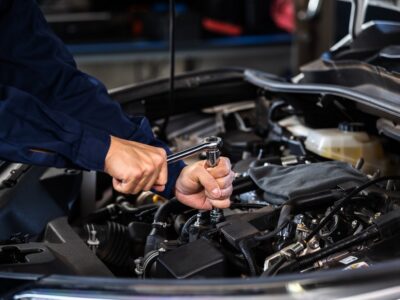Electric vehicles (EVs) have surged in popularity as environmental concerns and advances in technology drive the shift towards sustainable transportation. An electric vehicle’s battery management system (BMS) is among its most crucial components. The effectiveness of a BMS hinges on precise control and management of battery cells, and linear stepper motors play a significant role in achieving this. In this article, we explore how linear stepper motors are revolutionizing electric vehicle battery management systems and driving innovation in the automotive industry.
Battery Management Systems’ Essential Function
The brains behind the battery pack of an electric car are called battery management systems, or BMSs. It is in charge of keeping an eye on, controlling, and safeguarding battery cells to guarantee both safety and optimum performance. The BMS achieves this by balancing cell voltages, controlling temperatures, and managing charge and discharge cycles. The need for precise management inside the BMS has increased with the sophistication of electric cars.
Linear stepper motors have emerged as a game-changer in this arena due to their ability to provide accurate linear motion, making them ideal for tasks requiring high precision and reliability. For this reason, automotive engineers are increasingly turning to linear stepper motor manufacturers to enhance BMS capabilities.
How Linear Stepper Motors Work in BMS
Linear stepper motors are an adaptation of traditional rotary stepper motors, designed to create linear motion directly. These motors rely on a series of magnetic steps, converting electrical pulses into precise linear movement without requiring additional mechanical conversions. This unique capability allows linear stepper motors to deliver excellent accuracy and positioning, essential for advanced battery management systems.
Within a BMS, linear stepper motors can be used in various applications, such as controlling thermal management systems, adjusting cooling plates, or activating isolation mechanisms. By utilizing their high precision and reliable operation, linear stepper motors help ensure that battery cells remain within safe operating parameters, avoiding overheating, overcharging, or discharging.
Enhanced Precision and Control
One of the standout features of linear stepper motors is their ability to offer precise incremental movement. This capability is essential for the delicate task of balancing the battery cells within the BMS. As cell voltages can vary significantly, even minor deviations can impact the overall performance and longevity of the battery pack.
Linear stepper motors enable accurate voltage balancing, allowing the BMS to control the flow of energy between cells with great precision. By halting the deterioration of battery cells and increasing the battery pack’s total lifespan, this improves the BMS’s efficiency. As a result, linear stepper motor manufacturers are experiencing increasing demand from automotive OEMs and BMS developers.
Improved Thermal Management
The thermal management of battery packs is another critical area where linear stepper motors are making a difference. With the rising energy density of modern battery packs, effective thermal management has become more challenging. Neglecting to keep your car within the ideal temperature range can cause overheating, decreased performance, and in extreme situations, battery failure.
By using linear stepper motors to control active cooling systems or thermal management mechanisms, engineers can achieve dynamic temperature regulation. These motors can adjust airflow or reposition cooling elements with precision, allowing the BMS to respond quickly to changes in temperature. This capability not only improves the safety of the battery pack but also optimizes its performance.
Integration with Planetary Gear Motors
While linear stepper motors are making strides in battery management systems, they are often used in conjunction with planetary gear motors to provide enhanced torque and control. Planetary gear motors are highly efficient at transmitting power, making them ideal for applications where a high torque-to-weight ratio is required. Their compact design also complements linear stepper motors in space-constrained environments like EV battery compartments.
For example, when linear stepper motors are used for thermal management systems, planetary gear motors can be employed to drive coolant pumps or fans with the necessary torque and speed. This combination enables a comprehensive approach to temperature regulation within the BMS, enhancing both efficiency and safety.
Benefits of Linear Stepper Motors in BMS
The incorporation of linear stepper motors into electric vehicle BMS offers several key benefits:
- Precision Control: Linear stepper motors allow for fine incremental adjustments, ensuring accurate balancing of battery cells and preventing voltage imbalances.
- Reliable Performance: With minimal mechanical components, these motors offer high reliability and low maintenance, making them ideal for automotive applications.
- Compact Design: Linear stepper motors can fit into tight spaces within the BMS, providing manufacturers with flexibility in design.
- Thermal Regulation: The ability to dynamically adjust cooling systems ensures the battery pack remains within optimal temperature ranges, improving performance and extending lifespan.
The Future of BMS and Linear Stepper Motors
As electric vehicles continue to evolve, battery management systems must become more sophisticated to meet the demands of higher capacity and energy-efficient battery packs. Linear stepper motors are well-positioned to support this evolution due to their versatility and precise control capabilities.
Manufacturers of linear stepper motors are anticipated to be key players in the advancement of new BMS technologies in the future. These innovations will likely include more advanced balancing mechanisms, enhanced thermal management systems, and integrated monitoring solutions. The collaboration between BMS developers and manufacturers of linear stepper motors and planetary gear motors is expected to lead to groundbreaking advancements in electric vehicle technology.
Conclusion
Battery management system innovation in electric vehicles has been largely attributed to linear stepper motors. Their ability to provide precise control, enhance thermal management, and work in conjunction with planetary gear motors makes them an essential component in the next generation of electric vehicles. As the demand for efficient and reliable EVs grows, so too does the need for advanced linear stepper motors to push the boundaries of battery management systems.
For automotive engineers and BMS developers, partnering with a reliable linear stepper motor manufacturer is crucial in achieving the precision and performance required for modern EVs. By leveraging the capabilities of linear stepper motors and planetary gear motor manufacturers, the automotive industry is set to drive even greater innovation in battery management systems and electric vehicles.








Comments